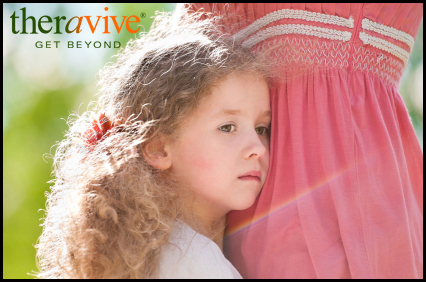 Long thought to be a psychological disorder that occurred only in adults, depression now is diagnosed frequently in children under 10 years of age. As recently as 40 years ago, physicians doubted the existence of depression in children (Son & Kirchner, 2000). Now one study reported in American Family Physician (ibid) suggested 2% of children under the age of puberty can be diagnosed with some form of depression.
Long thought to be a psychological disorder that occurred only in adults, depression now is diagnosed frequently in children under 10 years of age. As recently as 40 years ago, physicians doubted the existence of depression in children (Son & Kirchner, 2000). Now one study reported in American Family Physician (ibid) suggested 2% of children under the age of puberty can be diagnosed with some form of depression.
Males are more frequently diagnosed with depression at these ages. By adolescence and into adulthood, females are more frequently diagnosed with this disorder.
Even though depression in children is being diagnosed more frequently, there still are many children who suffer from this disorder but aren’t diagnosed. Often, the symptoms of depression in children are considered normal behaviors and emotions seen in children.
At times, especially in younger children, these signs and symptoms are shown as irritability or anger. This “masking” of symptoms confused professionals in the past, leading to misdiagnosis of depression in children. With increasing research and training, the likelihood of this kind of misdiagnosis is decreased.
In their desire to protect their children from problems, parents may confuse depression and shyness. This is understandable because depression and shyness share some characteristics, as will be shown later in this article.
Shyness has proven difficult to study due to problems defining the condition. Investigators know shyness when they see it expressed behaviorally, but can’t define it specifically. Research has focused on specific characteristics of the condition for the most part.
Prevalence of shyness in children has been reported as high as 3% of children under the age of 12 (Beidel & Turner, 2007). This suggests the condition is a significant one for systematic study. This prevalence indicates a larger possibility of shyness than depression in children. This may be a reason parents report their children as being depressed with increasing frequency.
Typical Symptoms Of Depression and Shyness In Children
Comparing the symptom pictures of depression and shyness in children will lead to some distinctions between the two conditions. As will be seen, there are commonalities in typical presentations of the conditions. However, careful study of the symptoms will allow a differentiation in diagnosis.
Symptoms of Childhood Depression
Depression is a treatable condition in which a child’s ability to function at age/grade level is impaired to a significant degree. Typically, the symptoms continue for a longer period of time and may have a familial basis. Much of the time, children who are depressed will live in families where one or both parents are or have been depressed.
Some research (Harvard Health Publications, 2002) suggests a significant heritability factor. In fact, half of children whose parent has major depression in their history will have a depressive episode in childhood or adolescence. Other research findings have been inconsistent regarding the role of genetics in childhood depression.
There appears to be a significant probability of learning factors playing a major role in the development of childhood depression in families with at least one parent suffering from depression. After all, living with a parent who expresses the symptoms of depression during the early formative years of a child’s life will lead to significant vicarious learning. Thus, a child with symptoms of depression may have learned these behaviors by watching a parent exhibit them.
Typical signs and symptoms of childhood depression were reported on the “Facts for Families Pages” of the American Academy of Child & Adolescent Psychiatry (2013):
· Frequent sadness, tearfulness, crying
· Decreased interest in activities; or inability to enjoy previously favorite activities
· Hopelessness
· Persistent boredom; low energy
· Social isolation, poor communication
· Low self esteem and guilt
· Extreme sensitivity to rejection or failure
· Increased irritability anger, or hostility
· Difficulty with relationships
· Frequent complaints of physical illnesses such as headaches and stomachaches
· Frequent absences from school or poor performance in school
· Poor concentration
· A major change in eating and/or sleeping patterns
· Talk of or efforts to run away from home
· Thoughts or expressions of suicide or self destructive behavior
 Symptoms of Shyness in Children
Symptoms of Shyness in Children
In contrast to childhood depression, shyness in children is more difficult to pinpoint. This factor makes systematic investigation into shyness much more difficult. Varying operational definitions also add to the difficulty of rigorous investigation (Harris, 1984).
Regardless of the difficulty defining shyness in children, it appears to be an oft-occurring condition (Beidel & Turner, 2007, op. cit.). These authors reported a 3% prevalence of shyness in children.
Often, shyness has to be differentiated from social anxiety, a much more serious condition. Once children begin avoiding normal activities and relationships, what may have started as shyness is considered to be a disorder.
Shyness is typically considered excessive focus on self which includes close examination of thoughts, feelings, and the way one reacts physically. Most of the time, this close examination leads to negative evaluation of those thoughts and feelings leading to lowered self esteem.
Typical signs and symptoms of shyness in children include:
· Difficulty meeting people
· Desire to be social, but feel they can’t
· Avoiding interaction with others, especially strangers or people in authority
· Express self less, both verbally and nonverbally
· Show less interest in others, at least outwardly
· Avoid new situations
· Critical of their own actions, verbalizations, and feelings
· Bashful
· Nervous
· Passive; non-assertive
· Avoids eye contact
· Stammers
· Low self esteem
Comparing Childhood Depression and Shyness. Examining the above lists of symptoms of depression and shyness reveals commonalities and differences. The commonalities include factors such as avoidance of situations and other people, difficulty with relationships, low self esteem, absence from school and other activities, sensitivity to rejection or perceived rejection. Because of these similar symptoms, shyness may be misperceived as depression in children.
Some differences between depression and shyness in children include: shy children typically have a desire to be social, but cannot; shy children do not typically act angry or hostile; changes in sleeping or eating habits are not typical in shy children; runaway behavior is not usually seen in shy children; and thoughts or verbalizations about suicide are not typically present with shy children.
Does Shyness Lead To Depression?
The short answer to this question is, not necessarily. As is so often true in determining the relationship between psychological disorders and what might be their causes, there is not a clear pathway leading from childhood shyness to depression.
However, the two conditions do seem to be related, at least sometimes. There may be times that shyness may be a contributing factor to the development of depression. The reason for this lies in some of the commonalities between shyness and depression listed above.
Specifically, depression results from negative cognition about self and perceived rejection from others that leads to decreased energy and motivation. This same kind of negatively perceived self-image and the belief that others also label one as negative in one or many ways is characteristic of shy children and may lead to negative outcomes, including depressive symptoms (Rubin, Coplan, & Bowker, 2009).
Shyness results from low self-confidence and the real or imagined lack of acceptance by others. These lead to low self-esteem and withdrawal to protect oneself from rejection. This constant feeling of not being good enough can lead to a state of melancholy. These same characteristics form at least part of the core beliefs surrounding depression.
Society and its perception of and relation to shy individuals may also play a part in the formation of depression from shyness. Typically, shy people are seen as socially inept and inadequate by society as a whole. They may also be perceived as cold and aloof. Both of these qualities can lead to rejection and isolation.
From the available research, it appears there may be a relationship between shyness and the development of depression in children. This is not a given, however.
Simply because shyness and depression share some characteristics does not indicate shyness leads to depression. There is a possibility of the shared symptoms ultimately developing into depression, and this potential must be considered by parents and professionals when dealing with shy children.
There are many ways to alleviate the painful characteristics of shyness to prevent the possible development of depression. Perhaps the most helpful interventions in this area are the ones that directly deal with the negative cognitions so prevalent in shy children. Addressing and modifying these cognitions early may interrupt the cycle that develops into childhood depression. Shy children deserve this early intervention.
_________________________________________________________________________________________________________________________________
American Academy of Child & Adolescent Psychiatry. (2013). Facts for Families Pages. Washington, D.C.
Beidel, D.C., & Turner, S.M. (1998). Shy Children, Phobic Adults: Nature and Treatment of Social Phobia. Retrieved from http://www.webmd.com/anxiety-panic/features/kids-afraid-of-life?print=true
Harris, P.R. (1984). Shyness and psychological imperialism: on the dangers of ignoring the ordinary language roots of the terms we deal with. Eur J Soc Psychol., 14(2), 169-181.
Harvard Health Publications. (2002). Depression in Children – Part 1. Retrieved from http://www.health.harvard.edu/newsweek/Depression_in_Children-Part_I.htm
Rubin, K.H., Coplan, R.J., & Bowker, J.C. (2009). Social Withdrawal in Childhood. Annu Rev Psychol., 60, 141-171.
Son, S.E., & Kirchner, J.T. (2000). Depression in Children and Adolescents. Am Fam Physician., 62(10), 2297-2308.
About the Author
 C. Wayne Winkle
C. Wayne WinkleC. Wayne Winkle is a board-certified family psychologist with thirty years experience in the field. He earned his doctorate at Texas A&M University at Commerce where he wrote the major portion of a National Institute of Mental Health grant for the university. As a writer, he has published four novels with another on the way. His freelance writing also includes blog posts, web copy, sales letters, fundraising letters, and grant proposals for non-profits. He lives with his wife Vicki in Arkansas.
Professional Website:
http://www.theravive.com/blog/author/Dr.%20C.%20Wayne%20Winkle.aspx